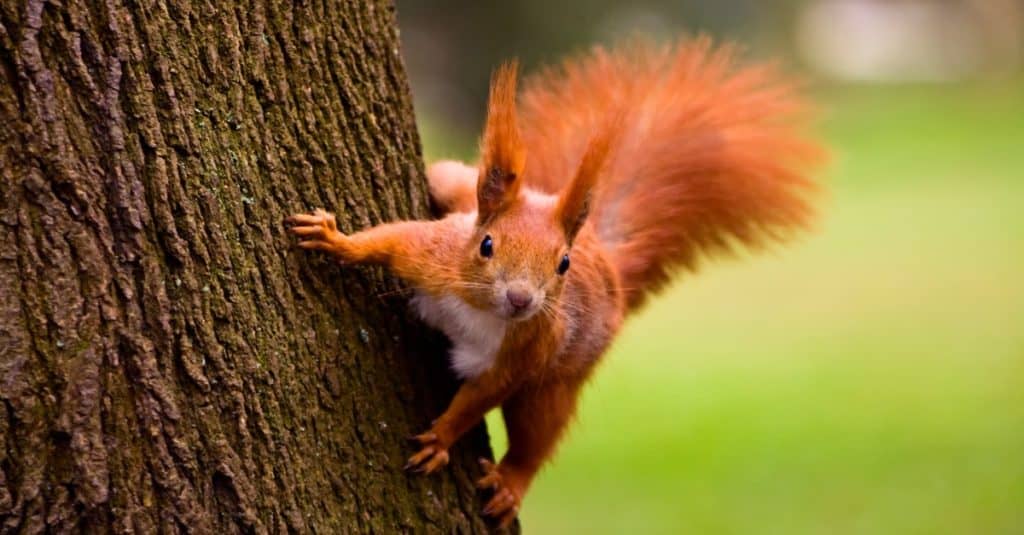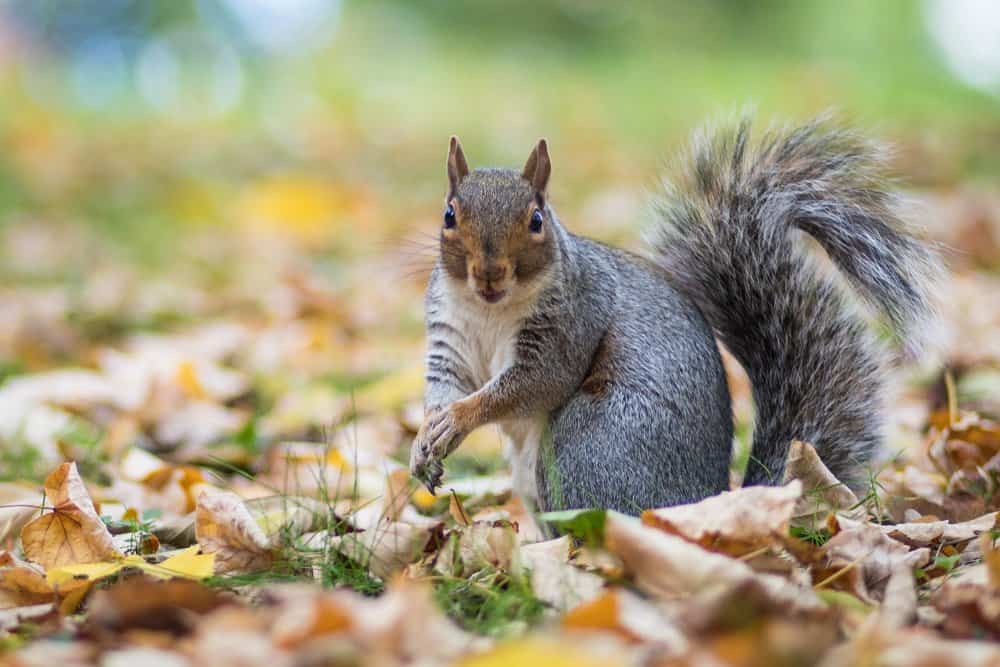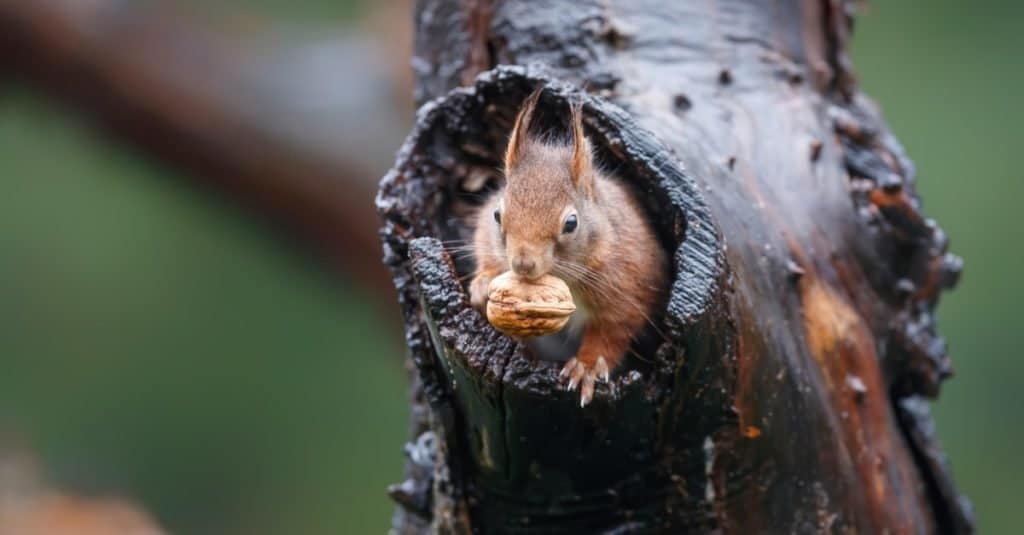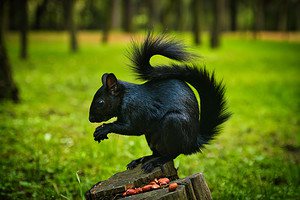Squirrels are some of the most prevalent rodents living across North America, although most people don’t consider them to be as “pest-like” as mice or rats. In fact, most are happy to see these energetic little creatures romping around backyards all over the world. Two of the most well-known squirrels across North America are the red squirrel and the grey squirrel. Although they are quite similar, they belong to different groups and have some clear distinctions. Let’s compare Red Squirrels vs Grey Squirrels and see what makes them unique!
Comparing a Red squirrel and a Grey squirrel

| Red squirrel | Grey squirrel | |
|---|---|---|
| Size | Smaller than most North American squirrels. Usually 10-15 inches long and slightly larger than a chipmunk. | Large squirrels. Usually 16.6-21.6 inches long. |
| Color | Rusty red with a white underbelly. | Most commonly grey, but is known to come in come in white, black, and brown. |
| Diet | Granivores but specialize in conifer seeds. Common foods include spruce seeds, mushrooms, berries, and even bird eggs. | Extremely variable. Foods include nuts, fungi, tree buds and bark, and garden crops. |
| Distribution | Canada, Alaska, the Rocky Mountains, and the Northeastern United States. | Eastern United States into southern Canada. Invasive in other countries around the world. |
| Habitat | Year-round territory of conifer forests, but has recently been expanding into hardwoods. | Large forested areas with nut trees. Urban and suburban environments. |
The 5 main differences between a red squirrel and a grey squirrel
The main differences between red and gray squirrels are that red squirrels have a more northern range, are smaller, and prefer a diet of spruce seeds. Grey squirrels are larger, have a southeastern range, and prefer nut trees.
The red and grey squirrels are among the most common species of squirrel across North America, although grey squirrels are known to be the most numerous and well-known. Both are considered rodents and are arboreal but are divided into differing genera. It’s also important to note that “red squirrels” and “grey squirrels” are common terms used in North America to describe the American red squirrel and the Eastern gray squirrel. “Red” squirrels live in Europe but are an entirely different species.
Between the two, identification is fairly easy. Red squirrels are rusty red with white bellies and are a little big larger than the average chipmunk. Grey squirrels are grey, although melanistic variations exist, causing them to be black, and are significantly larger than red squirrels.
Let’s explore these differences, plus a few more, in some more detail below!
Red Squirrel vs Grey Squirrel: Size

The American red squirrel is much smaller than the grey squirrel.
©seawhisper/Shutterstock.com
When it comes to size, red squirrels are among the smallest arboreal squirrel species in North America. They generally measure 10-15 inches long from head to tail and have a body size slightly larger than the average chipmunk.
Grey squirrels are much larger than red squirrels, especially in the northern ranges. They generally average 16.6-21.6 inches long from head to tail and can weigh as much as 1.5 lbs in some places.
Red Squirrel vs Grey Squirrel: Color

Grey squirrels are grey with white bellies.
©TheLiftCreativeServices/Shutterstock.com
As their names would suggest, red squirrels have rusty red fur covering their bodies. Their tails are often darker red and are occasionally ringed with a black line. Red squirrels often have lighter undersides, usually white bellies ringed in grey as it meets the red fur along their backs.
Grey squirrels are most commonly grey with a lighter belly that’s usually white. Interestingly, a melanistic variation exists in the northern ranges that have turned grey squirrels totally black, although they are still considered grey squirrels. This genetic variation increases their ability to thermoregulate, especially in lower temperatures. Other grey squirrel variations include white and brown, although they are less common.
Red Squirrel vs Grey Squirrel: Diet

Red squirrels primarily eat white spruce seeds, while grey squirrels prefer nuts like acorns.
©Henk Bogaard/Shutterstock.com
Most rodents, including squirrels, have a varied diet. Still, there are some dietary preferences that each species sticks to. Red squirrels primarily eat seeds, especially those of the white spruce tree. White spruce seeds can account for as much as 50% of a red squirrel’s diet. Additionally, they are known to eat buds, mushrooms, berries, and even bird eggs.
Grey squirrels mostly eat nuts from deciduous trees, although any bird feeder knows that they won’t hesitate to eat anything they can find. They also eat bark, tree buds, flowers, and berries.
Red Squirrel vs Grey Squirrel: Distribution

Grey squirrels are found across the eastern United States.
©iStock.com/Nigel Harris
Grey squirrels are found across the eastern portion of the United States and in southern Canada. Their southern range encompasses Florida. Additionally, they are considered an invasive species in countries around the world, especially in Europe.
Red squirrels can be found across most of Canada, except the large open areas without trees. Their range extends into the United States, primarily through the Rocky Mountains as far south as Arizona and in the northeast around New England.
Red Squirrel vs Grey Squirrel: Habitat

Grey squirrels prefer deciduous forests.
©Millie Bond – Copyright A-Z Animals
While both squirrels are arboreal, they prefer different regions. Red squirrels are most commonly found in coniferous forests, where spruce and pine trees make up the bulk of the biomass. Recently, however, studies show red squirrels are potentially expanding into other types of forests.
Grey squirrels are most densely populated in large regions of deciduous forests. Additionally, they can be found in urban and suburban areas and have adapted to humans extremely well.
The photo featured at the top of this post is © Giedriius/Shutterstock.com
Thank you for reading! Have some feedback for us? Contact the AZ Animals editorial team.






